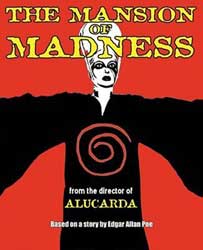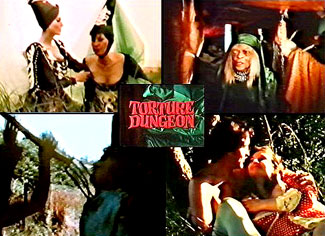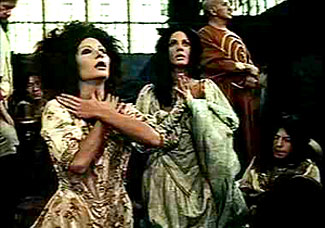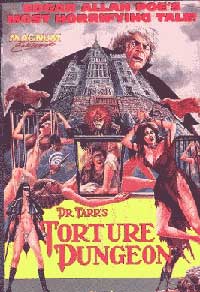 Reminiscent of Marat/Sade (1967) hybridized with Ken Russell's The Devils (1971), or like a Monty Python take on The Cabinet of Dr. Caligari (1921) or Luis Bunuel, The Torture Dungeon of Dr. Tarr (aka, The Mansion of Madness, 1973) has bizarre sets, stranger dialogue verging on surreal verse, & mad artfully choreographed motion. Reminiscent of Marat/Sade (1967) hybridized with Ken Russell's The Devils (1971), or like a Monty Python take on The Cabinet of Dr. Caligari (1921) or Luis Bunuel, The Torture Dungeon of Dr. Tarr (aka, The Mansion of Madness, 1973) has bizarre sets, stranger dialogue verging on surreal verse, & mad artfully choreographed motion.
Although it is a Mexican production, it was filmed in English. It was the slightly longer version, La mansion de la locura, that had to be dubbed into Spanish.
Dr. Maillard (Max Kerlow), who may or may not be who he claims to be, believes in a soothing treatment for the insane which amounts to pandering to their delusions. So if Mr. Chicken wants to live in some dank dark part of the madhouse always acting like a chicken, he's permitted. So too a group of violent madmen who have full liberty to come & go from the asylum are allowed to pursue their dream-occupation as a gang of loony highwaymen.
But there is also a torture dungeon at whose entry a gladly crucified madman, who believes he's Dante, is the tormented greeter. The infernal labyrinth is the less soothing aspect of the soothing system of permissiveness, as many a poor nutter either wants to be, or believes he or she deserves to be, maltreated unto death.
 Eugenie (Ellen Sherma), an insane but beautiful & highly philosophical woman, believes restfulness is indecent & that dance is purity. Eugenie (Ellen Sherma), an insane but beautiful & highly philosophical woman, believes restfulness is indecent & that dance is purity.
Claiming by her own testimony to possess unparalleled beauty & modesty, continuous dance is proof of her perfection.
Her entire sequence appears almost to have been inspired by the works of the Armenian director of folktale-like films Sergei Parajanov, but nowhere near as boring (though of course someone more familiar like Fellini is more apt to be an intentional antecedent).
Weird ceremonies are encouraged which heighten patients' delusions. Everyone creates their own tableaux from out of their warped imaginations, either heavenly or punishing. And whatever their choices, they are not judged harshly.
Plus the asylum has what is probably the weirdest band in any film outside the troll orchestra in Troll (1986), or the gas-masked extraterrestrial gramophone orchestra in To the Stars by Hard Ways (1981).
Our point of view character, Gaston (Arthur Hansel), is like Virgil led into hell, though quotations in the dialog about "the land of mist & snow" are from the Rime of the Ancient Mariner rather than Paradise Lost. And the story in general takes its primary cues from Edgar Allen Poe's vignette set within an insane asylum, "The System of Doctor Tarr & Professor Fether" (1856).
 That is the very system admired by Doctor Maillard, who is as mad as anyone in his asylum. His treatment requires all participants become immersed in the soothing system with full acceptance, or be destroyed by one's own resistance. This applies as much to doctors or staff as to the patients. That is the very system admired by Doctor Maillard, who is as mad as anyone in his asylum. His treatment requires all participants become immersed in the soothing system with full acceptance, or be destroyed by one's own resistance. This applies as much to doctors or staff as to the patients.
Gaston discovers he is unable to leave the asylum. He attempts to escape, convinced the doctor is an imposter, perhaps originally one of the inmates. Chivalry causes him to want to liberate the beautiful Eugenie from this place of torments, though warned of her violent deadly side. He is in love with her & will not believe her truly mad. He is, in fact, constructing his own fantasy, which Dr. Maillard, due to his system, in no way discourages.
It's a possibility that the "real" Dr. Maillard, Eugenie's father, is trapped deep in the dungeon, with a mad brigand pretending to be the doctor having effecting a hospital coup. When Gaston is recaptured & brought center stage in an orgiastic demonic feast, he is newly assured that the inmates indeed run the institution, though it is even then too inexplicable for certainties.
With the general look of a period horror film from Amicus or Hammer, the content evades such easy comparison. It is simultaneously beautiful, weird, & cheezy, as if Fellini or Bunuel themselves had ventured into the realm of shlock horror.
Continue to more madhouses:
Dark Asylum (2001) and Doom Asylum (1987)
copyright © by Paghat the Ratgirl
|


 Eugenie (Ellen Sherma), an insane but beautiful & highly philosophical woman, believes restfulness is indecent & that dance is purity.
Eugenie (Ellen Sherma), an insane but beautiful & highly philosophical woman, believes restfulness is indecent & that dance is purity. That is the very system admired by Doctor Maillard, who is as mad as anyone in his asylum. His treatment requires all participants become immersed in the soothing system with full acceptance, or be destroyed by one's own resistance. This applies as much to doctors or staff as to the patients.
That is the very system admired by Doctor Maillard, who is as mad as anyone in his asylum. His treatment requires all participants become immersed in the soothing system with full acceptance, or be destroyed by one's own resistance. This applies as much to doctors or staff as to the patients.